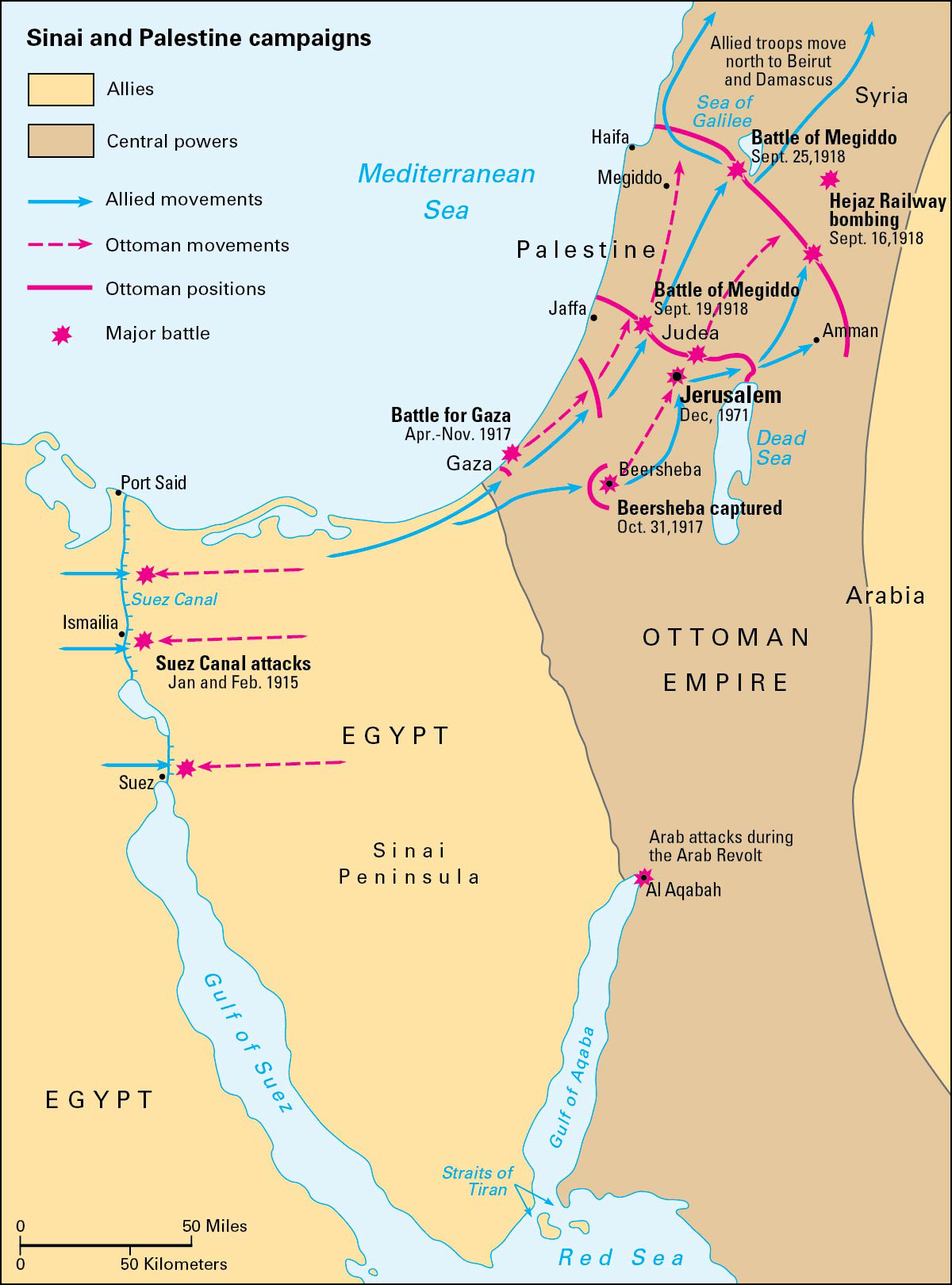Middle Eastern Front was a battlefront in southwestern Asia during World War I (1914-1918). The Middle Eastern Front was spread over great amounts of territory and included several different campaigns. This article discusses the largest of those campaigns. The front saw fighting mainly by the Allied armies of the United Kingdom and Russia against troops from the Ottoman Empire. The Middle Eastern front was just one of several battlefronts during World War I.

Background.
In October 1914, the Ottoman Empire—centered in what is now Turkey—formally joined Germany and Austria-Hungary of the Central Powers. At that time, the Ottomans controlled large areas of southwestern Asia. The empire, however, was in decline. The Ottomans, controlled largely by ethnic Turks, wished to solidify the empire and recover territory lost in earlier wars. They also wanted to prevent Russia, a long-time enemy, from gaining more control in the region.
Allied leaders viewed the Ottoman Empire as the weakest of the Central Powers. With no progress being made on other battlefronts, the Allies decided to try to knock the Ottoman Empire out of the war.
The Caucasus.
In November 1914, Russian and Ottoman troops began fighting in the Caucasus. The Caucasus is a region that includes present-day Armenia, Azerbaijan, Georgia, and a small portion of southern Russia. Fighting pushed the front into Ottoman territory and later into Russia, but in the end, neither side gained or lost much ground. Numerous battles killed thousands of soldiers. Large numbers of civilians also died (see Armenian Genocide). Allied forces in the Caucasus campaign were mainly Russian, but the Russian Revolution of 1917 effectively ended that nation’s war effort. Armenian and British troops continued fighting Ottoman forces in the Caucasus until the autumn of 1918. 
Gallipoli.
The Allies invaded the Ottoman Empire’s Gallipoli Peninsula in April 1915. The Gallipoli landing was at that time the largest amphibious assault (attack involving naval and land forces) in history. However, the Allies ultimately failed to advance against Ottoman defenses. The last Allied troops withdrew in January 1916. Allied forces in the Gallipoli campaign included soldiers from the United Kingdom, France, Australia, New Zealand, India, and elsewhere. A number of German troops aided the Ottoman effort.
Mesopotamia.
British troops invaded southeastern Mesopotamia, in what is now Iraq, in November 1914. The British advanced rapidly, gaining control of the area’s vast oil reserves. In November 1915, however, Ottoman troops stopped the British advance at the ruins of the ancient city of Ctesiphon. A large British force was then besieged at Kut-al-Amara (commonly called Al Kūt) and forced to surrender in April 1916. The British soon regained the advantage, however, entering the city of Baghdad in March 1917. By the autumn of 1918, British forces controlled nearly all of Mesopotamia. Indian troops made up the bulk of the British forces in the Mesopotamia campaign. 
Persia.
In December 1914, Russian and Ottoman troops began fighting for control of northwestern Persia (present-day Iran). Persia was not part of the Ottoman Empire, but its location—and oil reserves—made it a battleground. Russian troops sought to defend the oil fields at Baku just north of Persia on the Caspian Sea. The Russians also took control of much of northern Persia. In 1915, British troops occupied southern Persia to defend the Khuzestan oil fields. Local Qashqai and Tangistani rebels—led by German agents—fought unsuccessfully against the British occupation. Russia’s withdrawal from the war in late 1917 left much of Persia in British control. Large numbers of Armenian and Indian troops fought with the Allies in Persia.
The Sinai and Palestine.
In January and early February 1915, an Ottoman force invaded Egypt’s Sinai Peninsula and attacked British troops at the Suez Canal. The attack failed, and the Ottomans eventually withdrew across the Sinai into Palestine (a region including present-day Israel and the Palestinian territories). In 1917, British and French forces pushed into Palestine, resulting in heavy fighting at Gaza, Beersheba, and Jerusalem. In September 1918, the British defeated the last major Ottoman force at Megiddo, and the Ottoman front in Palestine collapsed. British forces quickly took Amman in what is now Jordan. The Allied armies then swept north to capture Damascus and Aleppo in Syria. British forces in the Sinai and Palestine included large numbers of Australians, New Zealanders, and Indians. A number of German and Austro-Hungarian troops fought with Ottoman forces. 
The Arab Revolt.
In 1916, Arab nationalists rebelled against Ottoman rule in what is now Saudi Arabia. Backed by the United Kingdom, Arab forces raided Ottoman troops, supply lines, railways, and communications. They also mounted large-scale attacks, taking the western cities of Mecca and Jiddah, as well as Al Aqabah in Jordan. By the autumn of 1918, Arab forces controlled Jordan, southern Syria, and most of the Arabian Peninsula. Among the British officers fighting with the Arabs was T. E. Lawrence, remembered as Lawrence of Arabia.
Aftermath.
Fighting on the Middle Eastern Front ended following the surrender of the Ottoman Empire on Oct. 30, 1918. Many thousands of soldiers died in the fighting in the Middle East. Illness and disease killed thousands more. After the war, the Ottoman Empire was dissolved, and most Arab lands were placed under British and French control. The rest of the Ottoman Empire became Turkey.
